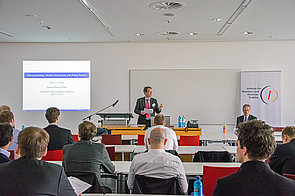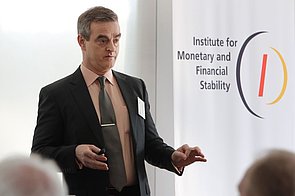IMFS-CEPR Research Meeting
New Methods for Macroeconomic Modelling, Model Comparison and Policy Analysis
April 5-6, 2016
Goethe University Frankfurt
Campus Westend
Directions


How is macromodelling useful for policy advice? At the research meeting as the first part of the 2016 edition of the IMFS Conference on Monetary and Financial Stability economists from international organizations, central banks and universities looked at „New Methods for Macroeconomic Modelling, Model Comparison and Policy Analysis“ from different points of view.
As a starting point, Robert Tetlow and Werner Röger showed how macromodelling is used in the Federal Reserve Board and the European Commission. Tetlow who is an Advisor at the Division of Monetary Affairs at the Board of Governors of the Federal Reserve System warned policymakers and advisors to be humble. “Despite large advances in recent years policy prescriptions of modern models are as fragile as ever,” he said. “It is difficult to judge whether one model is better than the other”. Comparing the role of the policy advisor and his linear rational expectation models to Hollywood movies he found various similarities: It starts with a shock, then the hero arrives and there is always a happy ending. However, Tetlow points out the importance of uncertainty regarding the data, the parameters and the models. Using the FRB/US model, the Board staff presents prescriptions of simple policy rules like the Taylor rule, Tetlow explained. In his view, simplicity matters. Therefore, Tetlow appealed to take a quantitative central tendency path for policy and target variables and then explicitly consider the uncertainty. “But you always have to consider how to communicate it to the public,” he concluded.
Werner Röger of the Directorate General Economic and Financial Affairs described how the European Commission had made a detour in macromodelling. “At the beginning of the crisis we have made our models more complicated, now we are going back to simpler models,” he said. At the EC, macromodelling encompasses a wide range of applications like fiscal policy as well as regulatory measures, evaluation of the impact of structural reforms and estimates of potential output and output gaps. Based on the EC’s QUEST3 model and various extensions, Roeger analyzed different views about the sources of the long slump in the euro area. “What would be the shocks to generate such a slump?” Roeger asked. Comparing restrictive fiscal policy, household deleveraging, financial constraints for investors and reduced productivity growth, Roeger identified total factor productivity (TFP) and investment wedges as important for the decline of GDP growth in the euro area.
For Michael Kumhof, Senior Research Advisor at the Bank of England, banks are not intermediaries of loanable funds. In his view the financing process leads to the digital creation of monetary purchasing power. “Funds first exist in the mind of the banker,” Kumhof explained. “They then materialize digitally along with the loan”. Thus, according to Kumhof macroprudential and monetary policy frameworks should be reevaluated using financing models of banking like the Bank of England has already started doing.
Based on Kumhof’s theory, Joannes Mongardini, Deputy Division Chief at the International Monetary Fund, stressed the role of banks as ways of leveraging the economy. “Banks play a critical role because they decide whether clients have a good or bad investment,” he said. As he captues the role of banks as leverage machines with a MAPMOD model Mongardini comes to the conclusion that the behavior of banks is highly non-linear which leads to boom-bust cycles.
Building a bridge between model comparison and policy making, Massimo Rostagno, Director of Monetary Policy at the European Central Bank, presented causes of inertia in monetary policy and the consequences. As a means of making model and policy comparison easy, Volker Wieland, Managing Director of the IMFS, outlined the features of the Macroeconomic Model Data Base (MMB). Based on this computational platform and its systematic approach, researchers can include new models, compare competing models and make robust policy recommendations.
Furthermore, in parallel sessions, researchers analyzed credit, banking and monetary policy, looking at questions of global banking, trade, financial globalization and the slow recovery after the financial crisis. The model-based assessments of fiscal policy were in the center of another session, focusing on fiscal multipliers, a narrative approach to a fiscal DSGE model and a simulation-based approach to the macroeconomic effects of the euro area’s fiscal consolidation. Questions of estimation and forecasting were also addressed in a session whereas aspects of financial frictions, open economies and policy effects were covered in a parallel discussion.
Programm (PDF)
5. April 2016
1:00 – 2:00 pm | Registration and Coffee |
2:00 – 2:10 pm | Welcome |
2:10 – 3:15 pm | Session 1: Macroeconomic Modelling and Policy Making Chair: Volker Wieland (IMFS)
|
3:15 – 3:45 pm | Coffee Break |
3:45 – 6:00 pm | Parallel Session 1a: Credit, Banking and Monetary Policy Chair: Michael Binder (IMFS)
Parallel Session 1b: Model-based Assessments of Fiscal Policy Chair: Gernot Müller (University of Tübingen)
|
6. April 2016
8:15 – 8:45 am | Coffee |
| 8:45 – 10:15 am | Session 2: Macroeconomic Implications of the Financial Sector Chair: Volker Wieland (IMFS)
|
| 10:15 – 10:45 am | Coffee break |
10:45 – 1:00 pm | Parallel Session 2a: Model Solution, Estimation, and Forecasting Chair: Gernot Müller (University of Tübingen)
Parallel Session 2b: Financial Frictions, Open Economies, Policy Effects Chair: Volker Wieland (IMFS)
|
1:00 – 2:30 pm | Lunch |
2:30 – 4:00 pm | Session 3: Model Comparison and Policy Making Chair: Michael Binder (IMFS)
|
4:00 – 4:30 pm | Coffee break |
4:30 – 6:00 pm | Steering Group Meeting |
Typically, 25 minutes will be reserved for paper presentations, 10 minutes for the discussant, and 10 minutes for general discussion.
